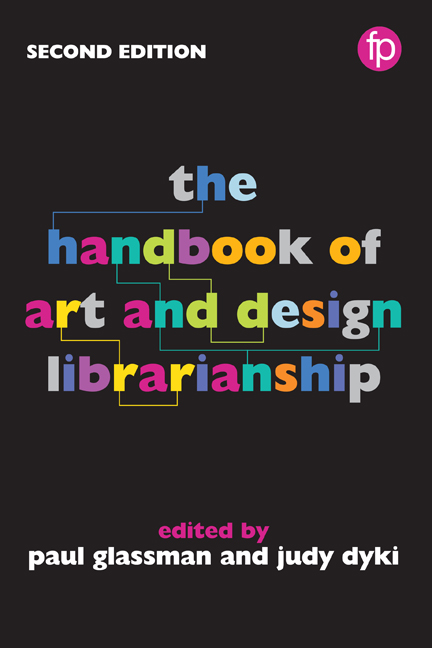Book contents
- Frontmatter
- Contents
- List of figures and tables
- Notes on contributors
- Foreword
- Preface
- Part I Roles and responsibilities
- 1 The governance and administration of the art and design library
- 2 Evolution not revolution: evolving trends in art and design libraries
- 3 Expanding roles for fine arts liaison librarians: re-visioning the liaison model
- 4 Accreditation and visual arts libraries
- 5 Design thinking for design librarians: rethinking art and design librarianship
- Part II Materials and collection management
- Part III Teaching and learning
- Part IV Knowledge creation
- Part V The physical environment
- Part VI Promotion and sustainability
- Appendix Library profiles
- Index
4 - Accreditation and visual arts libraries
from Part I - Roles and responsibilities
Published online by Cambridge University Press: 08 June 2018
- Frontmatter
- Contents
- List of figures and tables
- Notes on contributors
- Foreword
- Preface
- Part I Roles and responsibilities
- 1 The governance and administration of the art and design library
- 2 Evolution not revolution: evolving trends in art and design libraries
- 3 Expanding roles for fine arts liaison librarians: re-visioning the liaison model
- 4 Accreditation and visual arts libraries
- 5 Design thinking for design librarians: rethinking art and design librarianship
- Part II Materials and collection management
- Part III Teaching and learning
- Part IV Knowledge creation
- Part V The physical environment
- Part VI Promotion and sustainability
- Appendix Library profiles
- Index
Summary
Introduction
Accreditation in an academic institution can be viewed either as a necessary burden or as a valuable opportunity for careful self-examination, strategic planning and recommit - ment to the institution's mission. Most art and design school libraries balance the requirements of a regional accrediting agency along with those of one or more profes - sional accrediting agencies. The nature of art and design programmes often makes it difficult to address general accreditation standards, such as assessment of student academic achievement. Electronic collections, new technologies and new models of information delivery also challenge traditional accreditation measures. This chapter provides a general overview of academic accreditation purposes and processes, discusses self-study strategies for art and design school libraries that go beyond the required data collection and presentation of statistics, and provides recommendations as to how libraries can use the process to strengthen their resources and their role within their institution.
Global perspective on quality assurance in higher education
The voluntary, peer-review system of self-regulation used in American institutions of higher education is unique since in most other countries education is regulated by a national, state or regional governing body. American institutions show a high degree of diversity in size, purpose and scope, and the peer-review process helps each institution reach its full potential according to its mission. They operate with significant indepen - dence and autonomy. This is quite different from countries that have each developed their own governmental system of regulation and quality assurance.
In 1999, 29 European countries signed the Bologna Declaration, which was an attempt to make academic degree standards and quality assurance standards more uniform and compatible across the European Higher Education Area (European Higher Education Area, 2017). The number has since grown to 48. The goals of the Bologna Process were to provide a consistent approach to higher education governance and methods of evaluation, making it easier to move from one country to another for further study and ensuring a broad, high-quality system of education throughout the region.
Functions of accreditation
At its best, the process of accreditation encourages educational improvement and quality assurance through a combination of self-assessment and peer review. Many institutions use the process as a springboard for further strategic planning.
- Type
- Chapter
- Information
- The Handbook of Art and Design Librarianship , pp. 33 - 40Publisher: FacetPrint publication year: 2017



